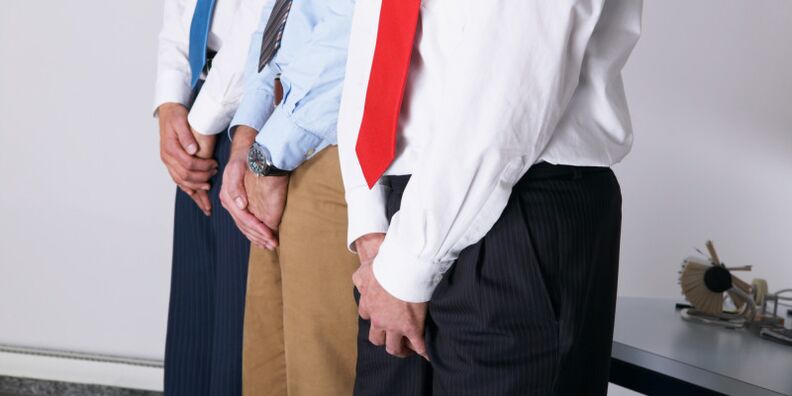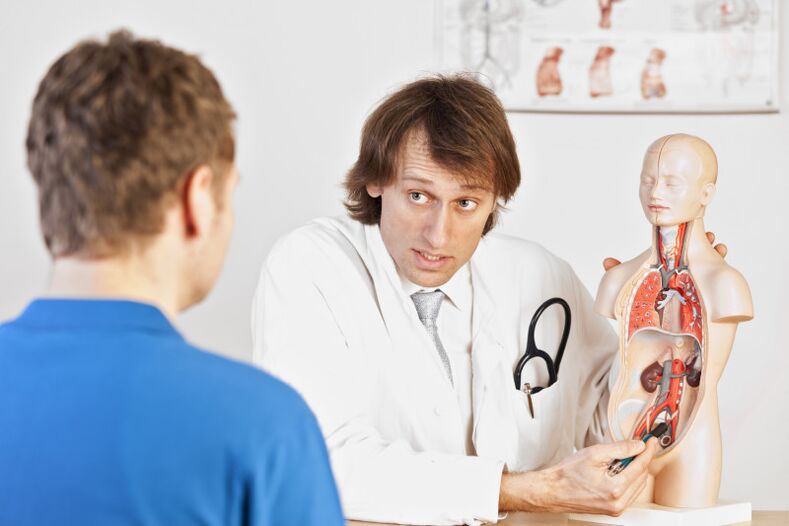
Prostatitis is a serious disease of the male genital area that often affects young men under the age of forty. Although the symptoms - decreased libido, difficulty urinating, lumbar pain - are very painful, males are not in a hurry for medical help.
And the reason for this is that there is not enough information about the disease, too many myths and prejudices circulate about it.
However, the manifestations of prostatitis only get worse over time, so you should contact a qualified urologist immediately if you have any signs of prostatitis.
Causes of prostatitis
Prostatitis is an inflammation of the prostate. Doctors classify the acute and chronic stages of the disease. If left untreated, the inflammation quickly becomes chronic and has a number of complications, such as impaired sexual function and even malignancy of the prostate.
What are the reasons for its occurrence?
Here are just a few:
- Sexually transmitted diseases. Men are often carriers of a particular infection without knowing it, as the disease is completely asymptomatic. However, this picture is very misleading. As soon as the immune system fails, for example due to a stressful situation, this gives impetus to the development of prostatitis. The most common pathogens of the disease are herpesvirus, fungi of the genus Candida, Escherichia coli, and so on.
- Untreated bladder infections. In this case, the infection easily spreads to the nearby prostate gland.
- Stagnation of blood in the pool area. This can lead to a sedentary lifestyle, an irregular sex life. In this case, there is a so-called non-bacterial prostatitis.
- Regular hypothermia, stress, the presence of infectious foci, including carious teeth, in the body.
- Inflammation of the prostate can be a complication of serious infectious diseases such as influenza, tonsillitis and others.
The main symptoms of prostatitis
The most common signs of this disease, regardless of the cause, are:
- decrease in potency;
- pain and difficulty urinating;
- pain of varying severity in the groin and genital area.
Symptoms of acute bacterial prostatitis
As mentioned above, the first stage of bacterial prostatitis is acute, lasting up to 3-5 days and then slowly becoming chronic.
It is very important not to miss the first symptoms of the disease:
- Pain in the groin and scrotum;
- Sharp pain while urinating;
- Drawing pain in the penis after intercourse;
- Deterioration of erection, decrease in duration of sexual intercourse.

A few days after the onset of the first symptoms, the pain is relieved, and men are given the deceptive impression that the threat is gone. However, this only means that the inflammation of the prostate is slowly but surely becoming chronic.
This course of the disease is characterized by:
- Alternating periods of remission and exacerbation of prostatitis;
- Difficulty urinating, frequent urge, and feeling of incomplete emptying of the bladder are associated with the above signs of the disease.
During the period of exacerbation of chronic bacterial prostatitis, patients suffer from the same symptoms as in the acute form.
Even seemingly harmless factors can trigger:
- hypothermia;
- Cold;
- An erection that had no realization;
- Avitaminosis;
- Stress and overtime;
- Sedentary lifestyle;
- constipation;
- Irregular sex life;
- Abuse of smoking and alcohol.
Symptoms of non-bacterial prostatitis
This disease is also called congestive prostatitis. This is the most dangerous and common type of pathology. Its formation is directly related to the lifestyle of modern man.
Medical researchers compare chronic stagnant prostatitis to dangerous diseases such as tuberculosis or cancer in terms of severity and frequency, as its neglected form is a direct route to prostate cancer.
This form of the disease can be discussed if the prostatitis is not caused by any microorganism, but by other factors - long absent sexual intercourse, sedentary lifestyle, regular stressful situations.
Such a conclusion can be drawn from the results of a bacteriological test showing the absence of pathogenic microorganisms.
The symptoms of this form of the disease are slightly different from the bacterial ones:
- Patients complain of intermittent or persistent dull pain in the pelvis, lower abdomen, groin, and genitals;
- Sexual dysfunction and urinary problems;
- Depressed mental state of patients
Symptoms of chronic asymptomatic prostatitis

This is a latent form of the disease. As the name suggests, it is an asymptomatic, i. e. inflammatory process in the prostate, but it does not affect the patient’s condition.
Some medical researchers tend to view this form of pathology only as a normal, age-related change in the prostate that occurs due to damage to the blood supply to the organ.
This disease is often discovered quite accidentally in a patient, for example during abdominal surgery with a completely different diagnosis.
To avoid prostatitis, you need to know the causes.
So the main measures to prevent prostatitis are:
- Although the main measures for the prevention of prostatitis, as has been mentioned many times, are regular sexual activity, it is still worth avoiding occasional sexual intercourse or it is absolutely necessary to use barrier contraceptives. This measure is mandatory because about 30% of cases of prostatitis are related to sexually transmitted diseases.Alternative sex- self-satisfaction is also welcomed by urologists, as the blood supply to the prostate is no less than full sexual intercourse.
- Physical activity, active lifestyle. Physical education and sports are useful as a general strengthening measure, but it is worth focusing on exercises that improve pelvic circulation. This includes running, skating, skiing, etc.
- Regular preventive examinations by a urologist or andrologist at least once a year.
- Timely treatment of foci of infection in the body, such as disinfection of the oral cavity.
The diagnosis of prostatitis is complex and multifaceted

The diagnosis of prostatitis is primarily related to determining the cause of the disease and includes the following steps:
- In order to clarify the picture of the disease, it is important to assess the patient, who must describe his complaints in detail - the localization of certain feelings, the duration of the events, the manifestations after which they started. In addition, the doctor will carefully examine the patient's medical record for previously transmitted diseases, tests, and examinations during the appointment. The urologist clarifies the patient's information about sex, the presence of sexually transmitted diseases.
- Examination of smear and scraping from the urethra. Increased leukocyte counts in the smear and the presence of abnormal microflora in the scraping indicate the presence of infection.
- General urine analysis. It helps to identify the presence of infection, the presence of which is indicated by an increased number of leukocytes (more than 5).
- Ejaculate analysis. To confirm the diagnosis of non-bacterial prostatitis.
- Ultrasound of the prostate. Allows you to view the image of the disease to the fullest. To clarify the diagnosis in both acute and chronic prostatitis when cancer is suspected.
Pain and decreased potency - as the first signs of prostatitis
Most often, doctors have to deal with an already advanced form of the disease, as most men tend to ignore the first alarm bells - lumbar pain and decreased libido, or the disease itself is asymptomatic for some time.
These are the peculiarities of the male anatomy - blood circulation in the prostate area is difficult, a "medium" for the growth of pathogenic microorganisms, and a sedentary lifestyle significantly exacerbates this problem. Therefore, the reason for the mass spread of prostatitis among truck drivers and office workers is becoming apparent.
One way or another, up to 50% of the world’s total male population has already experienced some symptoms of prostatitis. That is why it is so important to know the first signs of the disease and see a doctor in time. After all, treating an advanced form of the disease is a costly and lengthy undertaking.
A treatment that returns the patient to a full life

Of course, it is much easier to get rid of prostatitis at an early stage than from a neglected disease. Most often, however, doctors have to deal with the chronic form, and this usually requires long-term and complex treatment.
But in any case, you must first determine the cause of the pathology - stagnation of the blood and / or inflammation of the prostate.
So the complex treatment of prostatitis involves:
- Inflammatory processes are treated with a broad spectrum of antibiotics. In addition, the drugs are prescribed in the form of tablets and rectal suppositories. Infusions of herbs (chamomile, calendula) in the form of microclust are helpful in the complex.
- However, the treatment of prostatitis should not be limited to taking medications but should be aimed at restoring blood circulation to the prostate, and this includes physiotherapy and therapeutic practices. Such measures contribute to better absorption of antibacterial drugs by improving the blood supply to the prostate. Doctors often prescribe prostatitis: electrophoresis, laser therapy, magnetotherapy;
- Prostate massage. This procedure is useful and effective, but should not be performed at home without consulting a doctor, as it has many contraindications, including the acute phase of the disease.
In summary, the issue of treating and preventing prostatitis is highly dependent on the desire and activity of men. Basic morning exercises, regular preventive examinations at a urologist, a balanced diet - this is the key to male strength and longevity!



























